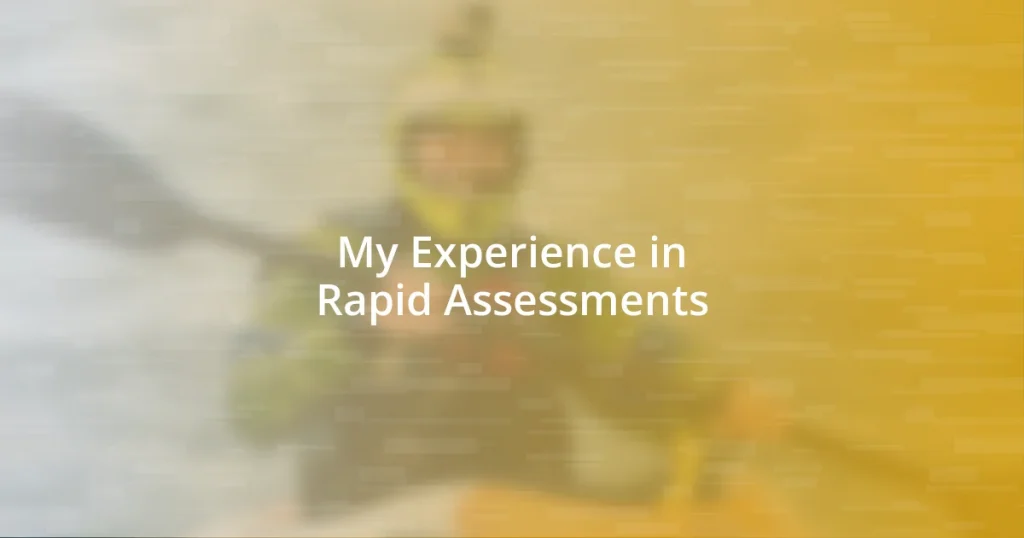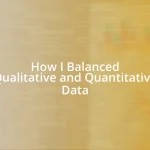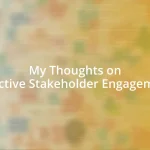Key takeaways:
- Rapid assessments are essential for timely decision-making in urgent situations, allowing for effective resource allocation and community engagement.
- Key steps include defining objectives, comprehensive data collection, and swift analysis to inform meaningful recommendations.
- Best practices involve clear goal-setting, collaboration with stakeholders, and iterative feedback to enhance assessment quality and impact.

Understanding Rapid Assessments
Rapid assessments are a powerful and dynamic tool used to gather insights quickly, especially in situations where time is of the essence. I remember being part of a team that had just days to evaluate community needs after a natural disaster. The pressure was immense, but the adrenaline also fueled our determination to make a real impact.
What I find fascinating about rapid assessments is how they can drive swift decision-making. It’s almost like piecing together a puzzle while on a tight deadline. The information collected, whether through surveys or interviews, often uncovers patterns we might not have typically noticed. Have you ever experienced that moment when a single data point suddenly clarifies a complex issue? It’s incredibly rewarding.
Moreover, the emotional aspect of conducting these assessments can’t be overlooked. While the fast pace can feel daunting, there’s a unique connection that forms with the community. I still recall speaking with local families, their resilience shining through despite challenges. It reminded me that behind every statistic lies a human story, and that sentiment keeps me grounded in my work.

Importance of Rapid Assessments
Rapid assessments play a crucial role in navigating the complexities of urgent situations. I recall a particularly intense experience where our team had to assess the mental health needs of displaced families within just 48 hours. The urgency not only heightened our focus but also the impact we could make. Gathering information swiftly allowed us to deploy resources effectively, which ultimately made a significant difference in those families’ lives.
Here are a few key reasons why rapid assessments are so important:
- Timeliness: They provide crucial insights quickly, which is vital in emergencies.
- Resource Optimization: Rapid assessments allow for a more efficient allocation of limited resources.
- Community Engagement: They foster relationships with communities, highlighting their needs and strengths.
- Informed Decision-Making: The data collected supports timely and evidence-based decisions.
- Flexibility: Rapid assessments can adapt to changing conditions and emerging patterns on the ground.
I’ve always found that these assessments not only inform strategic responses but also embody a deep respect for the communities we serve. Each conversation I’ve had during these assessments reminds me that my role is not just about gathering data—it’s about honoring the stories and experiences of individuals seeking support.

Steps in Conducting Rapid Assessments
When conducting rapid assessments, the first step is to define the objectives clearly. During one assessment I participated in, our goal was to identify immediate healthcare needs after a flood. This clarity allowed us to focus our questions and prioritize our interactions, ultimately saving valuable time.
Next, data collection is paramount. I remember using a mix of surveys and one-on-one interviews to gain diverse perspectives. When gathering information, being open and empathetic can yield deeper insights. It’s amazing how a simple change in tone or body language can transform a standard question into a heartfelt conversation, which often leads to unexpected and vital information.
The analysis comes after data collection. I have found that quickly sorting through the information, identifying trends, and drawing conclusions is essential in a fast-paced environment. It’s like putting together a jigsaw puzzle where every piece matters. The quicker we synthesize the data, the more effective our recommendations become for those who need immediate assistance.
| Step | Description |
|---|---|
| Define Objectives | Clarify the purpose to guide data collection effectively. |
| Data Collection | Utilize tools like surveys and interviews for a comprehensive understanding. |
| Analysis | Sift through data swiftly to identify trends and formulate recommendations. |

Tools for Effective Rapid Assessments
One of the most essential tools I’ve used in rapid assessments is mobile data collection apps. In one instance, during a community health evaluation, we leveraged these apps to gather data efficiently from multiple locations. It not only streamlined our process but also provided real-time analytics, making tracking issues far easier. Have you ever thought about how an app could transform data collection in your work? The convenience made a noticeable difference in our ability to respond quickly to the community’s pressing health needs.
Another powerful tool in my toolkit has been community mapping. I remember a project where we involved community members in visualizing their challenges and resources on a large canvas. It turned into a collaborative experience that brought people together and illuminated local strengths previously unnoticed. This not only deepened our understanding but also empowered the community to see themselves as active participants in their development. Can you see how community engagement can enhance your assessments?
Finally, I can’t stress enough how vital effective communication tools are—both in-person and virtual. During one rapid assessment, our team utilized a mix of video calls and in-person interviews to accommodate everyone’s circumstances. The connection fostered a safe space for sharing, leading to richer discussions. I found that the art of listening, coupled with open-ended questions, often unearthed powerful stories that statistics alone couldn’t convey. What tools do you currently use, and how do they help bring those personal stories to the forefront?

Analyzing Results of Rapid Assessments
Analyzing the results of rapid assessments can be overwhelming but incredibly insightful. I recall a situation where we processed survey responses and started spotting patterns that revealed not just immediate needs but underlying issues like access to healthcare. It felt like peeling back layers of an onion; each insight brought us closer to the core of the community’s challenges. Have you ever experienced that “aha” moment when the data starts telling a story?
I often find that visualizing the data can profoundly impact how we interpret our findings. In one assessment, I created simple charts and graphs to share with our team during a debriefing session. This transformation from raw numbers to visual representations sparked some passionate discussions. At that moment, I realized how visuals could bridge the gap between cold statistics and real, human experiences. How do you usually present your findings?
After the analysis, prioritizing actionable recommendations is key. I remember our team’s strategy session where we took our findings and brainstormed next steps. It was invigorating to witness everyone’s ideas come together to create a tangible plan for action. This collaborative approach not only made us feel more connected but also enhanced the quality of our recommendations. What methods do you employ to ensure your analysis translates into effective action?

Best Practices for Rapid Assessments
One best practice I’ve embraced in rapid assessments is establishing clear objectives from the start. During a recent initiative, we took the time to define exactly what we hoped to learn, which guided our entire process. This focus not only streamlined our data collection but also ensured that every question had a purpose—like a compass pointing us in the right direction. Have you ever set specific goals and witnessed the positive impact it makes on your outcomes?
Collaboration stands out as another crucial element. I find that involving diverse stakeholders in the assessment process significantly enhances the quality of our findings. For example, on one project, we organized a workshop where community leaders shared their insights and concerns. The richness of their experiences added depth to our understanding and reflected on the community’s true needs. How do you encourage collaboration in your assessments, and what benefits have you found?
Lastly, I believe in the importance of iterative feedback throughout assessments. In one rapid assessment, we conducted interim check-ins to present our preliminary results and gather reactions. This approach led to real-time adjustments and enriched later phases of the project. It’s fascinating to see how feedback can help refine our focus and amplify the value of our work. Could this practice enhance how you approach your assessments, too?

Overcoming Challenges in Rapid Assessments
I encountered significant challenges during rapid assessments, especially when time constraints felt suffocating. In one instance, we had only a week to gather information in a community that was grappling with multiple issues. The frantic pace made me anxious, but I harnessed that pressure by chunking the tasks into manageable pieces. How often do we underestimate the power of organization in chaotic situations?
Communication barriers can also pose hurdles in these assessments. I recall a project where language differences created misunderstandings with local participants. To tackle this, we enlisted bilingual volunteers who not only translated but helped convey the nuances of the questions. The subtle shift in approach made me realize the value of empathy in bridging gaps. Have you ever seen how a little effort in understanding can profoundly change the outcome?
Lastly, the emotional toll of rapid assessments can catch you off guard. While trying to navigate the facts, I often felt the weight of people’s stories pressing down on me. After an exhausting day of interviews, I would take a moment to reflect, reminding myself that behind the data were real lives and pressing needs. It made me wonder, how do you manage the emotional aspects of your assessments, and what strategies do you implement to keep that humanity front and center?















